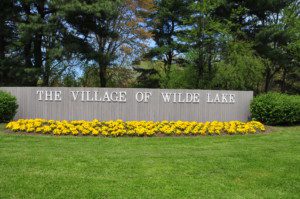
The entrance to The Village of Wilde Lake in Columbia, Maryland. Photo courtesy of Tom Lorsung and the Wilde Lake Community Association
Jim Rouse, the founder of the Enterprise Foundation (now Enterprise Community Partners), and his team designed and built Columbia, Maryland, in the turbulent 1960s against a backdrop of Cold War and domestic unrest. His city was designed “to nourish the growth of its people,” what he described as a city’s highest purpose. Rouse’s guiding questions were about making the environment human: as he said in one of the speeches collected in Jim Rouse and the American City, “What would a neighborhood, a community, a city be like that was designed to make people important, secure—physically, mentally, emotionally? What kind of place would encourage growth of personality, character, deep concern for fellow man?”
Columbia’s foundation is Rouse’s ideas about growing better people. Neighborhoods are designed to bring us out of our homes to know each other. My mailbox sits in the center of the neighborhood. Each day I must leave my home to get my mail, run into my neighbors, and talk with them. The homes themselves are laid out to foster socioeconomic integration. The row of townhouses where I live is between apartment buildings and single-family homes. Our children go to school together and we neighbors see each other at community and school events.
Rouse also built community control of land into the fabric and governance of Columbia.
- I live in a group of 95 townhomes; we have a small neighborhood association that maintains our common lands. We cooperate about flower planting, expenses for leaf and snow removal, and parking pads. We hold parties for Halloween and Independence Day. We have meetings, vote for board members, and argue and live together.
- My neighborhood is part of a larger village called Wilde Lake, which also has its own association with an elected board that guides our local affairs. We Wilde Lake residents also vote for board members, attend community meetings, and argue and live together. We appoint committees that manage the look and feel of our homes–the Resident Architectural Committee (RAC) meets twice monthly to consider neighbors’ desires to change their homes’ exteriors. We have shared neighborhood covenants, including architectural standards and tree removal guidelines.
- Wilde Lake is one of the 10 villages of Columbia, which is governed by the Columbia Association (CA). We Columbia residents vote for representatives to CA’s board of directors, which sets the vision for our shared spaces and other amenities. The regular board meetings include the Resident Speak Out, where any resident can be heard by the board on any topic. Rouse’s vision included community control of land through shared open spaces managed by CA. We have pathways, trails, tot lots, swimming pools, foot bridges, lakes, stream valleys, meadows, forests, basketball and tennis courts, and village center plazas.
Community control of land is labor-intensive. We attend meetings and elect boards at each level of living. Democracy is messy and takes effort and time. Knowing my neighbors and being jointly responsible for our shared spaces make that effort worth our time and help make us better people, with skills in making decisions together and practice caring for each other.


Comments